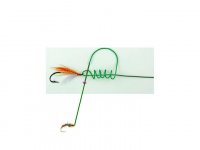There is no absolute correct way.
1. Tie tippet onto the bend of the hook of the dry.
2. Tie tippet onto the eye of the hook of the dry.
3. Up the tippet, if you have a blood knot, leave a long tag end. Tie dry to the tag end, use nymph as the "point". Make sure the tag is the thicker of the two lines.
4. If you have two tippet knots up the tippet, just clinch knot the dropper tippet in between them, so that the knots act as "stoppers" to keep the dropper from sliding too far.
Personally, with a dry-dropper set up, I use #2. However, as was stated, if my primary purpose is nymphing I don't use a dry as an indicator. I either tight line or use a strike indicator. That doesn't mean I don't use two flies, I often have 2 nymphs on. In those cases I generally use #3.
If you are going to use a dry-dropper, generally the requirement for the dry is that it floats well and is visible. As such, your typical brookie flies work well. Wulff's, Humpies, Elk Hair Caddis, stimulators, etc. Even a little foam or cork in the body helps.





